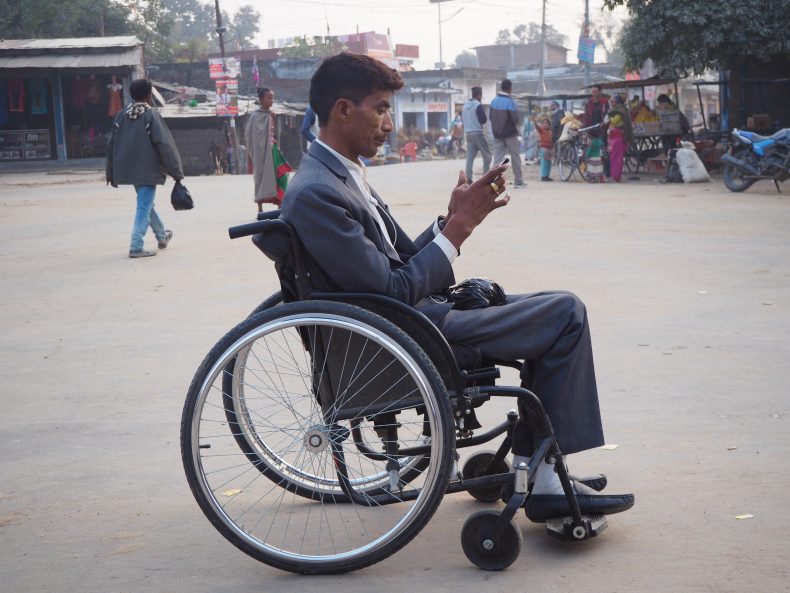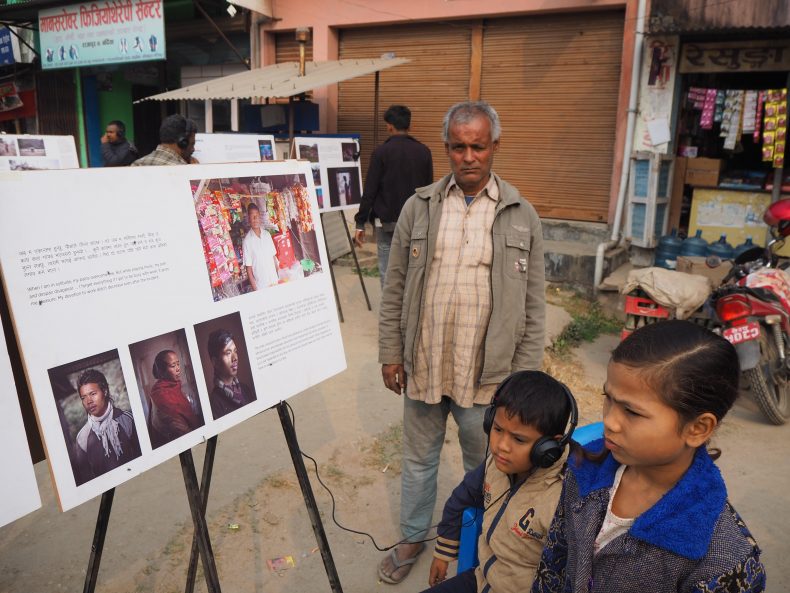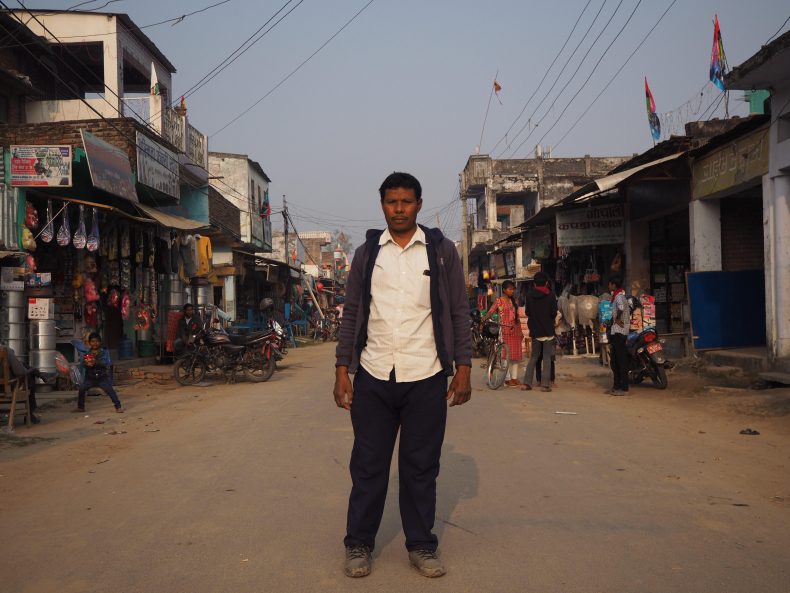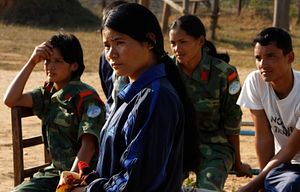On November 14, 2002, Krishna Ghising, a young father of two, boarded a bus from his village in eastern Nepal to Kathmandu, where he planned to apply for a visa to work in Korea. But as his bus was crossing a bridge in the village of Halhale, Dolakha district, a bomb planted by Maoist rebels – then in the midst of a decade-long insurgency – exploded. When Ghising woke up from a coma 19 days later, he was paralyzed from the waist down, and would spend the next nine months in the hospital.
Roughly a year later, on December 17, 2003, Gaya Prasad Chaudhary, another young father, was detained by state security forces on the other side of the country, in the village of Rajapur, Bardiya district, because they suspected him of Maoist activity. Though Chaudhary was innocent, the police beat him with iron pipes and electrocuted him with live wires before eventually releasing him. The torture resulted in spinal damage that has caused Chaudhary chronic pain. He walks with a permanent limp.
Several weeks ago, on a morning in early December 2018, Chaudhary and Ghising sat together on plastic chairs drinking tea at a public photography exhibition held in Rajapur, Chaudhary’s home town. The exhibition was organized by the Conflict Victims’ Common Platform (CVCP), an activist group representing war victims. Poster boards, set up on outdoor easels near Rajapur’s sole traffic circle, featured photographs depicting scenes from the daily lives of Chaudhary, Ghising, and 12 other war victims, several of whom were also in attendance.
Like most victims of Nepal’s civil war – which lasted from 1996 to 2006 and resulted in over 16,000 deaths, over 3,000 disappearances, and tens of thousands of injuries – all of the exhibition’s characters were innocently caught in the middle between Maoist and state security forces. In text accompanying the photographs, the victims told their stories of struggling to survive while paying for ongoing medical costs, and their desire for truth and justice regarding their attackers. The CVCP is currently taking the photo show — titled “14 Stories: Living Memories of War” — on tour throughout the country.
Some shoppers en route to a nearby market, where farmers sold fresh greens, radishes, and snails (a local delicacy) stopped to look at the exhibition, glancing at Ghising and Chaudhary when they recognized them from the photographs.

Krishna Ghising was paralyzed by a Maoist bomb blast in 2002. Image by Peter Gill.
“Sometimes I don’t even feel like a citizen because the government doesn’t consider our interests,” said Ghising.
Chaudhary nodded his head in agreement. “If the victims were important people, then the government would probably pay attention to us. But we’re from humble backgrounds, and so we are ignored.”
Although Nepal embarked on a transitional justice process to deal with wartime abuses in 2014, little progress has been made. Four years since their creation, a Truth and Reconciliation Commission and a separate Commission for the Investigation of Enforced Disappeared Persons have now registered over 65,000 complaints, but have not completed a full investigation of even a single case. Victims have yet to receive reparations, and no criminal prosecutions have begun through the transitional justice process (a handful of cases have, however, begun in normal courts). There is little political will to pursue an effective transitional justice process because the Maoists, who joined mainstream politics after the war ended, as well as other political parties and the Army, fear their leaders may be implicated.
Meanwhile, there is a general public apathy toward discussion of the war. For many people living in Kathmandu and other cities, the largely rural conflict never seriously affected their daily lives. For others living in rural areas, the war brought temporary suffering from which they have recovered, and which they would rather forget.
Inside his general store nearby the exhibition in Rajapur, Namdev Gyawali, a trader, was skeptical about the aims of the photography exhibition. “We need to forget about this. If we are always remembering what happened, we won’t get work done. Scratching old wounds will only create enmity.”
At a tea shop, Dhaniram Giri, a local businessman, voiced a similar opinion: “Rather than focusing on old wounds, the new generation should focus on developing the country, and prosperity.”
Of course, for conflict victims who lost loved ones, or were tortured or maimed – like Chaudhary and Ghising – moving on is easier said than done, especially when the transitional justice process remains stalled.
Transitional Justice Abroad and in Nepal
“Transitional justice” is a relatively new term in the English language, first used to describe the ways that former Soviet-bloc countries and South Africa in the 1990s addressed large-scale human rights violations committed under totalitarianism and Apartheid. Though approaches initially varied, some standards have emerged. Today, transitional justice is often spoken of as having four co-dependent “pillars”: truth-seeking by commissions of inquiry into human-rights abuses; criminal prosecutions, at least for the most serious crimes; reparations for victims; and institutional reforms (e.g. within the police, military, judiciary, etc.) to ensure similar abuses never occur again.
When the Maoists and the government signed a Comprehensive Peace Accord in 2006 ending the war, they committed to begin a transitional justice process to deal with serious human rights violations. Over the following eight years, however, transitional justice was largely ignored. The focus was on other aspects of the peace process, especially the integration of the Maoist and state armies (completed in 2012) and the promulgation of a new constitution (which finally happened in 2015, after many contentious debates). And there was little political will to engage in transitional justice because it could implicate leaders from the Maoists, the Nepali Congress Party (one of Nepal’s other major parties, which controlled the government for part of the war), and the police and army.
Eventually, however, pressure to undertake transitional justice in Nepal grew amid fears that leaders from both sides in the war could be prosecuted internationally. Prosecution by the International Criminal Court in The Hague was and remains unlikely because the Court lacks jurisdiction over Nepal, a non-member, unless the UN Security Council refers a case. However, in 2013, police in the United Kingdom arrested a vacationing Nepal Army colonel, Kumar Lama, under the principle of “universal jurisdiction.” Universal jurisdiction is a concept of international law, first applied in 1990s against former Chilean president Augusto Pinochet, whereby countries’ domestic courts can assume jurisdiction for serious human rights violations committed elsewhere by non-nationals. Colonel Lama, who was accused of torture during the war, was eventually acquitted in the U.K.; the plaintiffs were unable to collect evidence against him in Nepal due to the government’s lack of cooperation.
Universal jurisdiction is not meant to substitute for a homegrown transitional justice process, but rather to act primarily as a catalyst, creating political pressure for action within the countries where atrocities happened. In this sense, the Colonel Lama case was a partial success: in 2014, the Nepali government passed laws creating two transitional justice bodies, a Truth and Reconciliation Commission (TRC) and a Commission for the Investigation of Enforced Disappeared Persons (CIEDP). The Commissions would investigate human rights violations, ensure reparations for victims, and recommend serious cases to be tried under a yet-to-be-formed Special Court.
However, there were serious problems. Human rights organizations, including the UN Office of the High Commissioner for Human Rights, criticized the law for not guaranteeing the Commissions’ independence from politics and allowing them to recommend amnesty for perpetrators of serious crimes like torture and enforced disappearances, contravening international law. In 2015, Nepal’s own Supreme Court ordered the government to amend the laws to nix amnesty provisions, but the decision went unheeded. Meanwhile, the heads of the commissions were accused of being politicized, and there were reports that victims’ complaints were not kept confidential.
Successive governments led by the Maoists, the Congress, and Nepal’s third major political party, the Communist Party of Nepal-United Marxist-Leninist (CPN-UML), consistently understaffed and underfunded the Commissions, preventing them from carrying out their work. While the army remained mostly on the sidelines in political debates, it consistently maintained that its officers should not be subject to the Special Court, and instead should be tried by military courts that lack civilian oversight. Critics argued that the government had created the commissions merely to create the appearance of having a transitional justice process, thereby reducing the risk of international prosecutions and criticism.
Angered that the 2014 transitional justice laws were passed without consulting them, conflict victims began to organize for a more just and effective process. In September 2014, a variety of regional victims’ groups formed the CVCP — the group that organized the recent photo exhibition in Rajapur.

Children look at the the photo exhibition in Rajapur organized by the Conflict Victims’ Common Platform. Image by Peter Gill.
According to Suman Adhikari, the past president of the CVCP, whose own father was executed by Maoists, the group faced obstacles. At first, it was difficult to unite victims of the state security forces with victims of the Maoists. And different victims had different priorities.
“For wealthier victims, it might be putting perpetrators in jail. But for those who have trouble feeding their families, the priority is survival. They want reparations, support and jobs,” Adhikari told The Diplomat. Nonetheless, the CVCP advocated moving forward with all four pillars of transitional justice — truth seeking, prosecutions, reparations, and institutional reform. “When victims are united, they are stronger.”
However, the CVCP and other victims’ groups found only weak political support. The CPN-UML was once seen as a potential ally for victims because it was not in power during the civil war, and thus its leadership is largely free from implications in war-time abuses. However, after winning national elections in 2017, the CPN-UML merged with the Maoists in early 2018 to form the Nepal Communist Party (NCP), effectively neutralizing the CPN-UML threat to the Maoists. (Some political commentators have suggested that this outcome was a primary consideration in the Maoists’ calculations when deciding to merge.) With the NCP currently in power and the Nepali Congress — another party whose leaders could be implicated in war-time abuses — as the main opposition, the political landscape now lacks a strong voice for conflict victims.
Thus, despite the formation of the CVCP, victims have so far been unable to force a more effective transitional justice process. Four years since their creation, the TRC and CIEDP have not completed a full investigation of even a single case registered with them. (Roughly 2,000 “initial investigations” — which entail taking statements from victims, but no follow-up — have been completed by the CIEDP, and another 3,500 have been completed by the TRC.)
In the spring of 2018, some Nepali civil society groups floated a draft amendment to the 2014 transitional justice laws. While the proposal disallowed the Commissions from recommending amnesty for perpetrators, it did allow them to recommend reduced sentencing for those who show contrition, and was heavily criticized by other rights activists. In any case, the amendment was never voted upon in parliament, and seems to have quietly disappeared.
Meanwhile, victims struggle to survive without reparations. Though the government has provided 1 million Nepali rupees (roughly $8,900) to most victims of extrajudicial killings and disappearances, those living with disabilities and other injuries have received a pittance. People like Chaudhary, Ghising, and others featured in the CVCP photography exhibition were eligible for free initial treatment for their injuries, but only if performed at a government hospital. Follow-up treatments over the years have proved costly, and are generally not covered, due to difficulties in linking them to the original injury. Meager disability allowances are also available — for war victims and non-war victims alike — but these can be difficult to obtain due to bureaucratic hurdles, according to Basanta Gautam, a human rights activist and lawyer based in the city of Nepalgunj.
Establishing Trust
International experience suggests that establishing trust with victims, and legitimacy among society at large, is essential for successful transitional justice processes. In Nepal, however, the legitimacy of transitional justice has been hindered due to a consistent lack of consultation with victims when the government makes key decisions.
At the photo exhibition in Rajapur, victims are quick to voice discontent with the transitional justice Commissions.
“The Commission is just for bureaucrats to collect salaries. The Commission people have been playing politics, to keep their jobs,” says Ghising.
Dhani Ram Chaudhary, a man from a nearby village who was tortured by the army in 2003, says, “The people who sit at the Truth and Reconciliation Committee are not victims, and they don’t understand… Only people who have been tortured or injured during the war understand.” He suggests that everyone at the Commission be fired and replaced with new people, including positions for victims or their family members.
The role of victims in guiding the transitional justice process has become a point of serious contention in discussions of how to move forward. The TRC and CIEDP’s terms were initially for only two years, but each were given one-year extensions in 2016 and again in 2017 due to the slow pace of work. Their current terms expire in early February 2019, and as the deadline looms, a proposal has been put forward for a “high-level mechanism” of victims, government officials, and political party representatives to hash out agreement on transitional justice policy. The proposed mechanism would guide any amendment to the existing laws as well as the work of, and possible reconstitution of, the Commissions.
In November, following extensive internal discussions, the CVCP issued a charter listing their demands, which included the creation of such a high-level mechanism “with the involvement of all stakeholders.” Then, in early December, the Swiss government — which has played a role in supporting Nepal’s peace process since the end of the war — hosted a meeting in Bangkok for around a dozen representatives from political parties, the government, and civil society to discuss transitional justice issues. The meeting was organized in part by a former prominent human rights activist, Sushil Pyakurel, who has since entered government as an adviser to the president. With his connections in both human rights circles and within the ruling NCP party, Pyakurel was well-positioned for organizing such a dialogue event. Although results of the meeting have remained murky, it appears that discussions of a high-level mechanism were high on the agenda.
Although representatives from the CVCP were not invited to the Bangkok meeting, Bhagiram Chaudhari, the CVCP’s current president, whose brother was disappeared by state security forces, told The Diplomat that the high-level mechanism is important because it will help establish trust between victims and the government, which is a prerequisite for success. “Political commitment is needed first,” he said.
Kanak Mani Dixit, a prominent journalist who supports Sushil Pyakhurel’s initiative, says, “We have to be active. We cannot, ab initio, say this is going to be bad… If it looks like [the government] is going to actually hijack this process, that’s when we come out strong and stand against it.”
But other victims have opposed the proposal for a high-level mechanism, accusing those who support it of being duped by politicians, or worse. Protests were held in Kathmandu against the Bangkok meeting by those who saw it as a way to retain political control over the process. And recently, the debate over the mechanism led to a split within the CVCP, with some of its central committee members leaving to form their own group.
Om Prakash Aryal, a prominent human rights lawyer, says that the problem with the mechanism is that it will contain representatives of perpetrators, who cannot be expected to act in good faith. “Agents of the government have convinced the victims’ representatives, and are trying to frustrate, spoil, and dilute the transitional justice process,” he told The Diplomat. “The high-level mechanism is obviously a political mechanism, and it will continue the perpetrator-driven transitional justice process. They are looking for freedom from criminal accountability.”
In order to avoid political interference, Aryal and others have suggested a renewed role for the United Nations in the transitional justice process. But this proposal is also fraught with difficulty. The United Nations led a special Mission to Nepal from 2007-2011, which played a role in the early stages of the peace process, but the Mission was eventually pressured to leave. Different sides accused the body of bias, and resentment was bolstered by a feeling — not unique to Nepal — that the UN represented a vision of human rights that perpetuated Western interference in the domestic affairs of countries of the Global South.
Reparations, Prosecutions, and Learning From the Past
Human rights advocates in Nepal are divided between those who prioritize reparations for victims before proceeding with other aspects of transitional justice, and those who argue that reparations, truth-seeking, and prosecutions must all proceed simultaneously. Proponents of the former point out that many war victims are poor and struggling to survive, so priority should be placed on easing their economic burden. Critics argue that if reparations are settled on without simultaneously prosecuting human rights offenders, justice may never be carried out, leading to a continued culture of impunity.
Many of those who favor the proposed high-level mechanism also think reparations should be given first priority. “If you target prosecution and ignore other aspects of justice, then victims will have to suffer a lot,” says Chaudhari, the CVCP president.
Adhikari, the former CVCP president, agrees, saying, “What has happened is, the debate has been between prosecution or amnesty, and the other issues have been overshadowed.”
Among the dozen or so conflict victims The Diplomat spoke with at the Rajapur photography exhibition, economic reparations were clearly a top priority.
“We’ve sold our goats, our water buffalo, and our land, and I’ve taken loans to pay for my treatment,” said Ashok Sodari, who lost a leg after being tortured by Maoists.
Hira Tharu, a woman whose husband was disappeared by state security forces in 2003, said that the government should prioritize employment for surviving family members and education for their children. “The state must take care of me like my husband would have taken care of me,” she says.
But victims were concerned not only for their own livelihoods. In addition to reparations, all of those who spoke with The Diplomat also favored criminal prosecutions for those accused of serious crimes.
Some rights activists have drawn a connection between past and present impunity, arguing that the lack of reform within the security forces – and indeed the promotions of some officers accused of serious crimes – has created a culture that is still ripe for abuse. Over the past few months, the Nepali public has been shocked by apparent gross police misconduct during the investigation into the rape and murder of a 13-year-old girl, Nirmala Panta, that occurred in July 2018. In a recent Kathmandu Post opinion article, Mohna Ansari, a member of Nepal’s National Human Rights Commission, wrote: “Personally, I am convinced that had the case of Maina Sunuwar [a girl who was murdered by the Army in 2004, during the war] and others been properly dealt with by the justice system, then the chances of the Nirmala Pant case being so badly handled would have been greatly reduced.”
In Rajapur, several victims said that another way to prevent recurrence of atrocities is to educate the public about what happened during the war.
A group of schoolchildren passed by the photo exhibition, and asked one of the victims, who had no arms, to show them how he uses a pen; smilingly, he obliged. Nearby, Asha Chaudhary, a young woman who says she was tortured by the police as a child, remarked, “My generation knows about the war, but the generation below me knows nothing. The government needs to inform them about what happened. They need to learn that without peace, we can’t have a good education, we can’t get healthcare…”
Gaya Prasad Chaudhary, the host of the exhibition, agreed. “People have to survive, and so they often hide their suffering. If you show your weakness, then that can hurt others too, and affects our own outlook. But we need to talk about our suffering if we are ever going to get justice.”

Gaya Prasad Chaudhary was tortured by state security forces in 2003. Image by Peter Gill.
Peter Gill is a Kathmandu-based journalist. He tweets at @pitaarji,

































